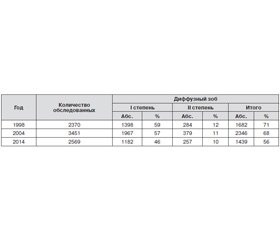Международный эндокринологический журнал 4 (68) 2015
Вернуться к номеру
Monitoring of the iodine deficiency disorders in Karakalpak region according to the epidemiological studies 1998, 2004 and 2014
Авторы: Ismailov S.I., Atadjanova M.M., Yuldashev F.Z., Rashitov M.M.
Рубрики: Эндокринология
Разделы: Справочник специалиста
Версия для печати
Iodine deficiency is the most widely spread thyroid pathology worldwide. The problem is urgent for Republic of Uzbekistan, as well [1, 2] The work was initiated to monitor iodine deficiency disorders (IDD) in dynamics within the period from 1998 to 2014 in Republic of Karakalpakstan.
Materials and methods
Iodine deficiency classification is based on mean urine iodine concentration in population. Ioduria median < 20 mcg/l indicates severe iodine deficiency (ID), moderate ID is represented by the value ranging from 20 to 49 mcg/l, range of 50-99 mcg/l is typical of mild ID. Goiter, as the most clinically pronounced iodine deficiency consequence, is one more criterion for assessment of iodine deficiency severity. Diagnosing of goiter in 5-19.9 % of population indicates mild iodine deficiency, range of 20-29.9 % reflects moderate iodine deficiency, the value > 30 % denotes severe iodine deficiency.
IDD monitoring included epidemiological examination of primary school students with collection of urine and table salt samples. Totally, 2,370 children were examined in 1998; 3,451 and 2,569 schoolchildren were examined in 2004 and 2014, respectively. Thyroid enlargement was evaluated by palpation in compliance with WHO classification (1994).
To qualitatively assess urine iodine 181 samples of the urine were collected in 1998; 120 and 180 samples (30 samples in each school) were collected in 2004 and 2014, respectively. In 1998, 2004 and 2014 iodine content in table salt brought by children from their households was determined in 130, 123 and 180 samples, respectively.
Sandell-Kolthoff reaction modified by the Center for Disease Control and Prevention (CDC) was used to measure urine iodine (2003). To measure iodine in table salt the iodide-iodate test based on reaction of an acid to produce free iodine and its titration with sodium thiosulfate was used (CDC, 2003).
Results and discussion
As the result of epidemiological study conducted in Republic of Karakalpakstan in 1998, diffuse goiter was diagnosed in 1,682 persons (71 %). In 94.5 % of collected urine samples iodine concentrations were unacceptable; the fact reflects severe iodine deficiency.
Iodine content in table salt determined, in 92.2 % of collected 130 samples table salt brought by children from home was found non-iodized. Thus, as per data of 1998, there was severe iodine deficiency in Republic of Karakalpakstan.
In 2004 random sampling technique was used to repeatedly study prevalence of goiter endemia. Prevalence of diffuse goiter, ioduria median and iodine concentration in table salt can be seen in Tables 1, 2 and 3, respectively. Results of data analysis demonstrated some improvement in the situation, to name decrease in goiter incidence, significant reduction in proportion of urine samples with minimal iodine content.
In 2014 in Republic of Karakalpakstan yet another examination of students in 6 primary schools was conducted. As a whole, the dynamics was positive. However, there was a reduction in number of households where table salt with optimal iodine content was used (Table 3) to be the evidence for insufficient control over salt iodization or storage conditions.
Conclusions
1. As a whole, results of IDD monitoring in Republic of Karakalpakstan within the period from 1998 to 2014 can be considered as the evidence for positive dynamics. IDD prevalence was found to gradually reduce from 71 % in 1998 to 56 % in 2014.
2. Severe iodine deficiency as per ioduria median was found to reduce from 94.5 % in 1998 to 4.4 % in 2014.
3. In 1998 iodine content in table salt was found to satisfy GOST (government standard) requirements in 7.8 % of samples only; the value was 43.1 % in 2004 reducing to 30 % in 2014. Thus, most children in Republic of Karakalpakstan (70 %) consume table salt not up with GOST requirements so far; the fact requires that appropriate authorities tighten control over the situation.

